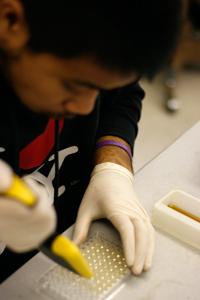
Deutschman Lab Projects
Much restoration effort has been focused on interaction the direct effect of grassland restoration on native and non-native plant composition. However, studies focusing on this interaction are often inconclusive, expensive, excessively long-term, or provide results that are in conflict with other published studies. Other conservation-centered studies have focused on direct and indirect interactions between plants and their environment. This includes the effect of plant species on soil characteristics such as nutrient availability and microbial composition. Conversely, the soil characteristics can have an effect on the aboveground plant community composition. Finally, interactions between plant species can occur both directly through competition or the release of chemicals or indirectly through the modification of soils.
This study will focus on the effect of restoration techniques on the soil. Further, this study will explain how restoration techniques indirectly influence the effect the interactions between soil characteristics and plant communities. In focusing the effect of restoration techniques on soil, this study will provide insight towards a mechanistic explanation for the success or failure of grassland restoration. In this study both field and lab experiments will be conducted in order to measure the response of soil in non-native grasslands that are actively being restored and then determine whether or not changes in soil chemistry, microbial composition and function influence aboveground plant composition. Furthermore, the belowground mechanisms through which non-native grasses become invasive will be examined, as well as determining how the establishment of priority effects is effected by soil amendments as a restoration technique.
Research Questions
Field Experiment:
1. In what ways do chemical weeding, irrigation, and seeding treatments affect soil chemistry in a California grassland being restored following fire?
2. In what ways do these treatments change the microbial composition present in California grassland soils and how does it change microbial functionality within the system?
3. How do the observed changes in soil chemistry, microbial composition and microbial function influence aboveground grass species composition and cover?
Lab (Greenhouse) Experiment:
4. Do soil amendment treatments affect plant priority effects, expressed through early germination and soil legacies, the invasive ability of non-native plants when grown with California native plants?
Lead Biologist: Benito Lo
Soil Composition and Function as Insight for Understanding Native Grassland Restoration Success

